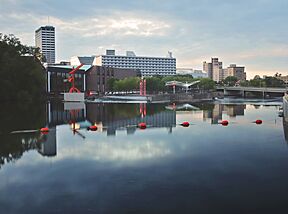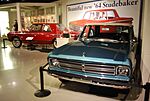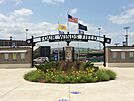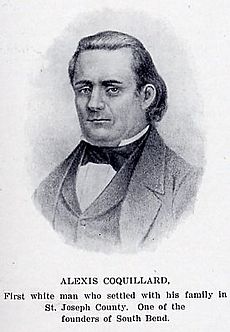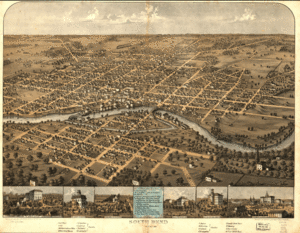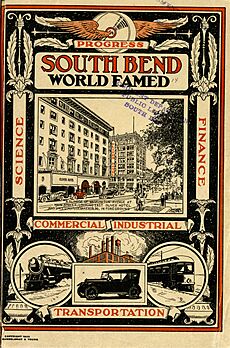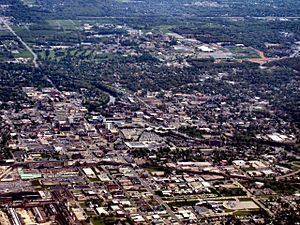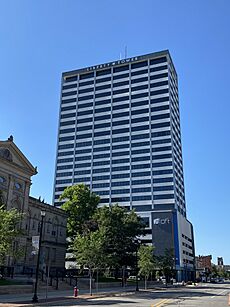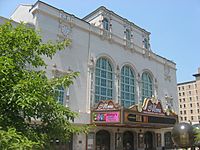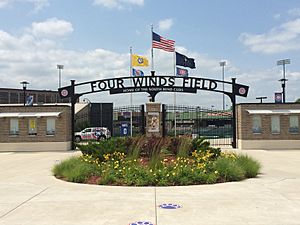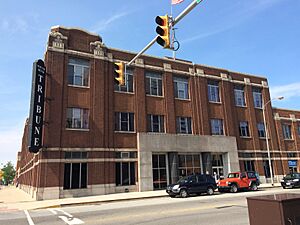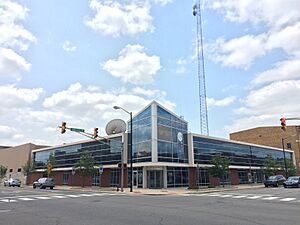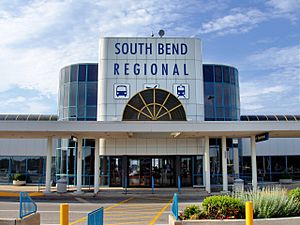South Bend, Indiana facts for kids
Quick facts for kids
South Bend
|
|||
|---|---|---|---|
|
|
|||
|
|||
| Nicknames:
Lotion City, Wagon City, Metropolis of Northern Indiana
|
|||
| Motto(s):
"Peace"
|
|||
| Country | |||
| State | |||
| County | St. Joseph | ||
| Incorporated (City) | 1865 | ||
| Founder | Alexis Coquillard | ||
| Government | |||
| • Type | Strong Mayor-Council | ||
| • Body | South Bend Common Council | ||
| Area | |||
| • City | 42.40 sq mi (109.82 km2) | ||
| • Land | 41.98 sq mi (108.72 km2) | ||
| • Water | 0.43 sq mi (1.10 km2) | ||
| Elevation | 719 ft (219 m) | ||
| Population
(2020)
|
|||
| • City | |||
| • Density | 2,464.57/sq mi (951.58/km2) | ||
| • Urban | |||
| • Urban density | 1,885.5/sq mi (728.0/km2) | ||
| • Metro | |||
| • CSA | |||
| GDP | |||
| • Metro | $35.608 billion (2022) | ||
| Time zone | UTC−5 (EST) | ||
| • Summer (DST) | UTC−4 (EDT) | ||
| ZIP Codes |
46601, 46604, 46612–46617, 46619–46620, 46624, 46626, 46628–46629, 46634–46635, 46637, 46660, 46680, 46699
|
||
| Area code(s) | 574 | ||
| FIPS code | 18-71000 | ||
| GNIS feature ID | 2395913 | ||
| Demonyms | South Bender, Domer (Notre Dame) | ||
| GDP | |||
South Bend is a city in Indiana, United States. It is the main city of St. Joseph County. The city gets its name from its location on the St. Joseph River, where the river makes a big bend to the south.
As of 2020, South Bend had over 103,000 people, making it the fourth-largest city in Indiana. It is located just south of the border with Michigan and about 72 miles (116 km) east of downtown Chicago. The wider area around South Bend has a population of over 324,000 people.
People first settled here in the early 1800s, and it became a city in 1865. The St. Joseph River was very important for South Bend's economy for a long time. It helped big factories like the Studebaker Corporation and the Oliver Chilled Plow Company grow.
After 1960, the number of people living in South Bend went down. This happened because many people moved to the suburbs. Also, big factories like Studebaker closed. Today, the main jobs in South Bend are in health care, education, small businesses, and tourism. The city's culture and economy are also greatly shaped by the nearby University of Notre Dame.
Contents
Exploring South Bend's Past
Early Days and First Settlers
Long ago, the St. Joseph Valley was home to Native American tribes. The Miami tribe lived there first, and later the Potawatomi tribe moved in. They used the river for food and resources. The area was special because it had the shortest path between the St. Joseph River and the Kankakee River. This path was used for hundreds of years by Native Americans, and then by French explorers and traders.
In 1679, a French explorer named René-Robert Cavelier, Sieur de La Salle, was the first European to visit what is now South Bend. He used this important path between the two rivers.
The first European settlers were fur traders. In 1820, Pierre Frieschutz Navarre came to the area. He worked for the American Fur Company. Another agent, Alexis Coquillard, set up a trading post. In 1827, Lathrop Minor Taylor also started a trading post.
By 1829, the town was growing. Coquillard and Taylor were important leaders. They asked for a post office, and Taylor became the first postmaster. The town was first called Southold, but its name was changed to South Bend the next year. This was to avoid confusion with other towns named Southold.
In 1831, South Bend was chosen as the main town for St. Joseph County. It had 128 residents. That same year, Horatio Chapin moved to South Bend and opened the first general store. He also helped start the first church and Sunday school. The town was officially created in 1835, with Chapin as its first leader.
A famous person named Schuyler Colfax lived in South Bend. In 1841, he became a county official. He later bought a newspaper and made it support the Whig Party. Colfax was elected to Congress in 1855 and became the Speaker of the House in 1863. He even became the Vice President of the United States in 1868 under President Ulysses S. Grant. Colfax is buried in South Bend.
Growing Industries and New Beginnings
From the late 1830s to the 1850s, South Bend grew because of its factories. These factories were built along man-made canals called "races" on the St. Joseph River. Dams were built, and factories appeared on both sides of the river.
In 1851, the first steam locomotive arrived in South Bend. This meant that goods could be moved by railroad instead of just by river. In 1852, Henry Studebaker started his wagon shop. It grew to be the biggest wagon maker in the world. Later, it became the only wagon company to successfully make cars.
Other big companies like the Singer Sewing Company and the Oliver Chilled Plow Company also made South Bend a manufacturing hub. Many European immigrants came to South Bend for jobs in these factories. They came from places like Poland, Hungary, Ireland, Germany, Italy, and Sweden.
South Bend was also helped by its location on the Michigan Road. This was a main road in northern Indiana in the 1800s. Another important event happened in 1842 when Father Edward Sorin founded the University of Notre Dame just north of the town. This university became a huge part of the area's economy and culture.
South Bend officially became a city on May 22, 1865. Its first mayor was William G. George. The city's motto, "Peace," was chosen because it became a city right after the American Civil War ended.
Factories grew quickly after the Civil War. Good jobs and high pay attracted many immigrants from Europe. Most of these new residents were Catholic.
The first African American church in South Bend, Olivet African Methodist Episcopal (AME) Church, was founded in March 1870. It is still an active church today.
Modern South Bend: Changes and Growth
More industries developed in South Bend in the early 1900s. These included the Bendix Corporation, Honeywell, and the South Bend Lathe Works. Workers at the Bendix Corporation even held the first "sit-in strike" in American history in 1936.
Fast growth led to electric rail transportation. In 1925, the South Shore streetcar service started. It connected downtown South Bend to downtown Chicago. This line still runs daily and carries freight.
By 1950, more than half of all jobs in South Bend were in manufacturing. But things changed. The Studebaker car plant, which once employed 45,000 people, closed in 1963. Other factories also declined. By 2000, manufacturing was only a small part of the local economy.
Because of the job losses, the city's population dropped by almost 30,000 people. This decline in industry and population led to South Bend being part of the "Rust Belt" region of the United States.
In 1984, South Bend leaders wanted a minor-league baseball team. A stadium was built in 1986. The team was first called the South Bend White Sox, then the South Bend Silver Hawks, and finally the South Bend Cubs in 2015. They are a Class A minor league team linked to the Chicago Cubs.
In 2015, South Bend celebrated its 150th birthday. The city's population grew that year, the biggest growth in over 20 years. The old Studebaker plant is now being developed into Ignition Park. This area aims to attract new businesses, especially in the tech industry. South Bend has seen new growth and a renewal of its downtown area.
South Bend's Location and Environment
South Bend is about 5 miles (8 km) from the Michigan border. It is also about 93 miles (150 km) from Chicago. The shore of Lake Michigan is about 20 miles (32 km) away.
The city covers about 42 square miles (109 square km). Most of this area is land, with a small amount of water.
City Layout
The St. Joseph River flows through South Bend. It turns north near the city center, which is how South Bend got its name. The downtown area is in the north-central part of the city, along the river. Notre Dame, Indiana, is right next to South Bend to the north. Mishawaka, Indiana, is next to South Bend on the east side.
Local Weather
South Bend has a humid continental climate. This means it has warm summers and cold winters. Lake Michigan greatly affects South Bend's weather. It causes a lot of lake effect snow in winter and helps keep temperatures more moderate year-round.
The warmest months are June, July, and August. Snow usually falls from October through April. On average, South Bend gets about 64.5 inches (164 cm) of snow each year. Spring and fall can be mild, but also have strong storms.
People and Economy
Who Lives in South Bend?
As of the 2020 census, South Bend had 103,453 people. The city is home to a diverse population. About 50% of residents are White, 25% are Black or African American, and 1.5% are Asian. About 16.7% of the population is Hispanic or Latino.
Many different backgrounds make up South Bend. In 2013, the most common ancestries reported were African-American, German, Irish, and Polish.
How South Bend Makes Money
South Bend's location on the St. Joseph River helped it become an industrial city in the past. In 1923, a businessman named Vincent H. Bendix chose South Bend for his new factory. He made car parts. He picked South Bend because it was on a rail line between Chicago and Detroit, which were big car-making cities.
After World War II, manufacturing started to slow down. The Studebaker plant, which once had 45,000 workers, closed in 1963. Other factories also closed or became smaller. By 2000, manufacturing was only 16% of the local economy.
Since the 1960s, education, health care, and small businesses have become the most important parts of South Bend's economy. The nearby University of Notre Dame is a huge employer, with over 6,000 people working there.
Health care is also a big part of the economy. Beacon Health System is the largest employer in the city, with over 7,000 workers. Other important companies include Honeywell, Bosch, and AM General.
Top Employers in South Bend
Here are some of the largest employers in South Bend:
- Beacon Health System (Memorial)
- University of Notre Dame
- South Bend Community School Corporation
- Indiana University South Bend
- St. Joseph County
- City of South Bend
- Four Winds Casino
- AM General
- The South Bend Clinic
- Press Ganey
Technology and New Growth
South Bend is working to bring in new businesses. The St. Joe Valley Metronet is a 50-mile (80 km) fiber optic network. It helps with fast internet connections. This network has attracted many data centers to South Bend. The city even offers free wireless internet in its downtown area.
The Union Station Technology Center is Northern Indiana's largest data center. There are plans to expand it into a big high-tech hub called the Renaissance District.
Innovation and Ignition Parks
Innovation Park and Ignition Park are special technology parks in South Bend. Innovation Park is near the University of Notre Dame. It helps companies and university researchers work together. Ignition Park is south of downtown. It is being built on land that used to belong to the Studebaker Corporation. It aims to have 3 million square feet (278,709 square meters) of high-tech space.
City Improvements
South Bend is working to fix up old industrial buildings. The old Oliver Corporation buildings are an example of property being reused. The city also had many empty homes after factories closed. In 2013, the city started a plan to fix or remove 1,000 empty homes in 1,000 days.
The Smart Street Initiative started in 2013. It is a plan to make the city safer for people walking, biking, and driving. It is changing some one-way streets to two-way streets. This helps bring more businesses to the area and makes travel easier.
Arts, Culture, and Fun
Local Culture
South Bend's culture has been greatly shaped by the many Polish Catholic immigrants who arrived in the late 1800s. Special days like Dyngus Day (the Monday after Easter) and Fat Tuesday are widely celebrated. paczkis (Polish donuts) are a popular food on Fat Tuesday. The city and nearby county have many Catholic churches and schools.
Music Events
South Bend hosts several yearly festivals. The South Bend International Festival features local and international music. The World Pulse Festival is a yearly Contemporary Christian music festival that attracts many visitors.
A local music festival called Sounds by South Bend celebrates local bands and artists. Its goals are to connect the communities of South Bend and Notre Dame, support local art, and help local businesses.
Museums and Entertainment
The South Bend Museum of Art is located downtown. It opened in 1996 and shows art from local artists. It also offers classes for kids and adults.
The History Museum
The History Museum tells the story of northern Indiana. It includes The Oliver Mansion, a 38-room house built in 1895. This mansion is listed on the National Register of Historic Places. It belonged to Joseph Doty Oliver, whose father founded the Oliver Farm Equipment Company. The museum also has areas about the St. Joseph River Valley, the University of Notre Dame, and a children's museum.
Studebaker National Museum
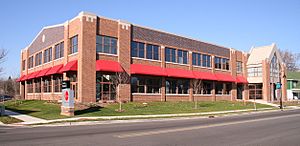
The Studebaker National Museum has a large collection of wagons and cars from the 150-year history of the Studebaker Corporation. The company gave this collection to the city in 1966. The museum is next to The History Museum, and together they are called The Museums at Washington and Chapin. The former mansion of Clement Studebaker, named Tippecanoe Place, is now a restaurant.
Civil Rights Heritage Center
The Indiana University South Bend Civil Rights Heritage Center is in an old swimming pool building. This pool used to keep African Americans out or separate them. In 2010, Indiana University South Bend reopened the building. It now offers tours and events about civil rights and the experiences of different groups in South Bend.
Theaters and Shows
The Morris Performing Arts Center, built in 1922, used to be a vaudeville theater. A famous movie about football coach Knute Rockne premiered here in 1940. The theater was saved from being torn down and was renovated in 2000. It hosts Broadway shows and the South Bend Symphony Orchestra.
The South Bend Civic Theater, started in 1957, performs many plays each year. It has a main stage and a smaller studio theater.
Other Art and Culture Spots
- The Raclin Murphy Museum of Art at the University of Notre Dame has over 30,000 art pieces.
- The DeBartolo Performing Arts Center at Notre Dame hosts plays, concerts, and films for the public.
- The Fischoff National Chamber Music Association holds the world's largest chamber music competition in South Bend.
- Schuyler Colfax, a former Vice President of the United States, is buried in South Bend City Cemetery.
Public Library
South Bend has a public library system called the St. Joseph County Public Library. It has a main library and several branches. The main library was fully remodeled and reopened in 2021.
Places to Worship
South Bend has many places of worship, including:
- Cathedral of St. James
- First Presbyterian Church
- St. Adalbert Catholic Church
- St. Casimir Catholic Church
- St. Matthew Cathedral
Sports and Recreation
South Bend Lions FC
The South Bend Lions FC is a soccer team in the USL2 league. They play at TCU School Field. In 2022, they became the Champions of the USL2 Valley Division.
South Bend Cubs Baseball
The city is home to the South Bend Cubs, a Class A Minor League Baseball team. They play at Four Winds Field at Coveleski Stadium downtown. In 2014, the team became linked with the Chicago Cubs. Before that, they were called the South Bend Silver Hawks.
The Ballpark Synagogue is a unique 1901 building located on the ballpark grounds. It serves as the team's fan store. It is the only ballpark synagogue in the country. The stadium also hosts many community events.
South Bend Roller Girls
South Bend also has a non-profit roller derby league called the South Bend Roller Girls. They were founded in 2010. Their competitive team, The Studebreakers, is named after the historic Studebaker Corporation. They help raise money for local charities.
East Race Waterway
South Bend has the first artificial whitewater center in North America, called the East Race Waterway. It is next to Century Center. This waterway is one of only a few artificial whitewater facilities in the United States. It is used for boating and water sports.
Other Sports Fun
- During World War II, the South Bend Blue Sox All-American Girls Professional Baseball League team played in the city.
- The Blackthorn Golf Course in South Bend hosts the Four Winds Invitational golf tournament.
- The Notre Dame Fighting Irish sports teams bring a lot of excitement to the area. Fans come to watch football, basketball, and other college sports.
- South Bend and Notre Dame hosted the Special Olympics World Games in 1987.
Parks and Outdoor Activities
South Bend's Parks and Recreation department manages over 50 parks, golf courses, and recreation areas. Some notable parks include Rum Village Park, which has a disc golf course and mountain bike trails. Potawatomi Park has a large playground for everyone and an outdoor performance area.
The Potawatomi Zoo is the second oldest zoo in Indiana. It started in 1921 with a single deer donated by Albert R. Erskine, the president of the Studebaker Corporation. The zoo now has over 400 animals.
Near the zoo are the Potawatomi Greenhouses and the Ella Morris and Muessel-Ellison Botanical Conservatories. These beautiful greenhouses and conservatories have many plants.
The city encourages bicycling as a way to get around. In 2010, South Bend was recognized as a "Bicycle-Friendly Community." The city has a plan to build a 116-mile (187 km) South Bend Bikeway network. As of 2014, over 66 miles (106 km) of bike routes have been created.
Learning and Education
Colleges and Universities
The South Bend area has several places for higher education:
- Indiana University South Bend is the third-largest campus in the Indiana University system.
- Purdue Polytechnic South Bend
- Ivy Tech Community College
- Trine University
Colleges located very close to South Bend include:
- University of Notre Dame
- Saint Mary's College
- Holy Cross College
- Bethel University
Schools for Kids
Public schools in South Bend are run by the South Bend Community School Corporation. They operate primary schools (grades K–5), intermediate schools (grades 6–8), and high schools (grades 9–12).
There are also several private schools. These include Trinity School at Greenlawn and The Stanley Clark School. The Diocese of Fort Wayne-South Bend also runs 11 Catholic grade schools and one high school in South Bend.
Media and News
Newspapers
The main daily newspaper for the South Bend area is the South Bend Tribune.
Radio Stations
South Bend has many radio stations. They play different types of music and shows, including public radio, sports radio, classical music, religious music, country, classic rock, pop, and urban contemporary.
Television Channels
South Bend is part of a large TV market. Most major television networks have channels broadcasting in the area.
Here are some of the TV stations in the Greater South Bend area:
| Cable Channel Number | Call Sign | Network |
|---|---|---|
| 16 | WNDU-TV | NBC |
| 22 | WSBT-TV | CBS |
| 25 | WCWW-LD | CW |
| 28 | WSJV | Heroes & Icons |
| 34 | WNIT-TV | PBS |
| 46 | WHME-TV | Univision |
| 57 | WBND-LD | ABC |
| 69 | WMYS-LD | MyNetworkTV |
City Services and Travel
Getting Around South Bend
Roads and Highways
South Bend's streets follow a grid pattern, but they also adapt to the path of the St. Joseph River. Major roads like State Roads 2, 23, and 933 connect South Bend to other areas. U.S. Route 20 and 31, along with Interstate 80 and 90 (the Indiana Toll Road), also pass through the city.
The St. Joseph Valley Parkway helps drivers get around the South Bend area. The Indiana Toll Road goes through northern South Bend.
Bus Services
South Bend has a Greyhound bus station for travel to other cities.
Public transportation within South Bend is run by Transpo. Transpo operates bus routes in South Bend and Mishawaka. In 2015, Transpo added new buses that run on compressed natural gas. The main bus station is the South Street Station.
Air Travel
The South Bend International Airport is in the northwest part of the city. It connects South Bend to larger airports in cities like Atlanta, Chicago, and Orlando. In 2014, the airport changed its name to "South Bend International" after getting international status.
Train Travel
The South Shore Line is an electric commuter train. It runs from the South Bend Airport station to downtown Chicago several times a day. There are plans to extend this train line to a new station downtown South Bend.
Amtrak, the national passenger train system, also serves South Bend Station. Trains like the Lake Shore Limited and the Capitol Limited connect South Bend to cities like Chicago, New York City, and Washington, D.C.
South Bend used to have electric streetcars from 1885 to the 1930s. In 2021, a group suggested building a new streetcar system to connect Notre Dame, South Bend, and Mishawaka.
City Utilities
Electricity in South Bend is provided by Indiana Michigan Power. Natural gas comes from the Northern Indiana Public Service Company (NIPSCO).
The South Bend Water Works provides water to residents. The water comes from 32 deep wells. In 2008, South Bend started using smart sensors and valves to manage its sewer system. This helps the city save money and makes the system more efficient.
Law Enforcement
The police force in South Bend has grown and changed over time. It started in 1831 with the first constables. The department officially became the South Bend Police Department in 1903.
Environmental Efforts
In 2015, South Bend partnered with the University of Notre Dame to improve the Bowman Creek ecosystem. Bowman Creek is a small river that flows into the St. Joseph River. This project aims to clean up the creek and improve the surrounding neighborhoods.
Famous People from South Bend
Many interesting people have come from South Bend.
Sister Cities
South Bend has four sister cities around the world:
 Częstochowa (Poland)
Częstochowa (Poland) Arzberg, Bavaria (Germany)
Arzberg, Bavaria (Germany) Guanajuato (Mexico)
Guanajuato (Mexico) Bergisch Gladbach, North Rhine-Westphalia (Germany)
Bergisch Gladbach, North Rhine-Westphalia (Germany)
See also
 In Spanish: South Bend (Indiana) para niños
In Spanish: South Bend (Indiana) para niños


